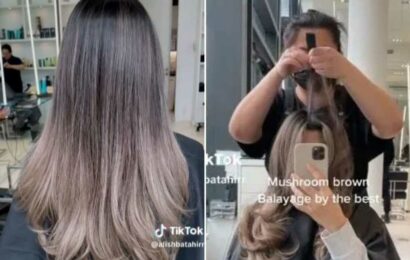It has been 12 months since Russia began a brutal invasion of Ukraine, forcing millions to flee the country and devastating the local economy, including the budding Kyiv fashion scene.
The war is the reason that Ukraine Fashion Week came to London this season, with three designers — Ivan Frolov, Ksenia Schnaider and Julie Paskal — presenting new fall collections on Feb. 21, the final day of shows at London Fashion Week.
All of Ukraine’s fashion brand founders have faced numerous difficulties: deciding whether to leave their country or stay behind while under near constant attack; keeping their businesses afloat from a new city; and creating beauty in the face of such uncertainty.
Here, four Ukrainian fashion designers share their stories of Feb. 24, 2022, and the months that followed. For them, continuing their creative work is not just a way of life — it is an act of resistance.
Ivan Frolov is the creative director of the women’s wear brand Frolov, which he founded in 2015. He has created looks for Dua Lipa, Gwen Stefani and Sam Smith, among others.
A few days before the war began, I gave an interview to Women’s Wear Daily. I told them that there was no way that the Russians would invade Ukraine. But at 5 a.m. on Feb. 24, bombs began falling around my apartment in central Kyiv. Friends from around the world started calling to check that I was alive. I found my mother and drove her for 30 hours to the west of the country, sending Telegram messages to my team, telling them to do whatever they could to stay safe.
After a few weeks, we started sending messages so that we could take part in the war effort, and I returned home. We’re experts in constructing corsets and bras and evening gowns. Instead, when our production lines started again, we were making uniforms, bulletproof vests and rocket and grenade holders.
I had many offers to help me move abroad. But, in the end, I knew I had to remain in Kyiv. For me, personally, to be a Ukrainian fashion brand meant I had to stay in Ukraine. Only four of my team left, primarily because they had kids. Everyone else has stayed — around 35 people — and they need money to survive. If anything, we have hired more people because we have brought on freelancers to do embroidery work.
I am proud of all we do. Though if I’m honest, there are more difficult moments than good ones. My brand has always been about sex and sexuality and celebration, but it is hard in war to sew sparkles on party outfits when rockets are flying overhead and the walls keep shaking around you. The mental challenges, the sense of guilt about what we are doing, can be enormous.
But there is sometimes joy. In January, I was making my way from Kyiv to Paris for couture. It involves a special permit, 24 hours via trains to Poland and then a very long bus ride from Warsaw. So I was standing alone at a snowy Polish bus station, trying to manhandle three suitcases of clothes and feeling so cold when my phone rang. Had I seen the news? Beyoncé was wearing a hot pink Frolov minidress covered in Swarovski crystals that I had designed as her finale look for a huge hotel opening in Dubai. The moment had gone viral online. Surreal doesn’t even cover it. I cried.
Before the war, something like that had been my ultimate dream. Now I have another. Victory for Ukraine.
Ksenia Schnaider is the creative director of KseniaSchnaider, which is best known for its upcycled denim collections. She started the line with her husband, Anton, in 2011.
I used to live near Kyiv airport, so on the morning of Feb. 24, I woke at dawn to the sound of massive explosions. I didn’t leave my apartment that day. I just looked out the window and watched bombs go off and hundreds of people running with suitcases. I just couldn’t believe that what I saw was real. The next day, my husband, daughter, some friends and their dog — and me — piled into a car and drove 20 hours to western Ukraine. It was bumper-to-bumper traffic the whole way, and for the next weeks we slept on a different sofa in a different house every night. Eventually, because of my child, I made the decision to leave, and we traveled to Budapest.
For a while, I felt like I could never design again and that I’d lost my brand. My team were scattered all over the world, our headquarters in Kyiv were now dangerous and we had left a season of clothes orders there, unshipped, that never made it to retailers. I divided all the money we had left in the company account to our employees.
But in the spring, my team started reaching out again. Most have husbands in the army, and they need to feed their children. We asked international partners if we could produce some of our best-selling designs, albeit at a small scale. Amazingly, some of our deadstock suppliers in eastern Ukraine were still working, so we could source fabrics. I also did a collaboration with a New York denim brand, DL1961.
In the summer, after months of zero sales, people in Ukraine started buying again. Zara and other foreign brands had all left. But then came fall and the blackouts, and shelling began again.
In September, we moved to Britain as part of a rehousing scheme called Homes for Ukraine. We now live in the guesthouse of a British family’s home in Sussex. I’ve been back to Ukraine three times since the war started, but I often feel guilty for not being there. Showing at London Fashion Week feels like a ray of hope and a chance to create new designs again. It is a chance to make sure the world remembers the vibrant Ukrainian fashion industry that existed before last year.
Julie Pelipas is a former fashion director of Vogue Ukraine and the founder of Bettter, which produces upcycled tailored collections from deadstock fabric. Ms. Pelipas is a semifinalist for the 2023 LVMH Prize for young fashion designers.
Everyone told me I was being foolish, but I had a very strong premonition in February last year that I had to leave Ukraine. I put four seasons of clothes in a suitcase and took my children to stay with my mother, who lives in Greece. For weeks, people just kept saying “Come home,” so I booked flights home. They were for Feb. 24, which proved to be the day the tanks rolled in.
I think I was fearful, because I had already seen what could happen. My apartment is in the center of the city, and during the 2014 revolution, I saw people dying on the streets as I breastfed my baby at the window. I didn’t want my kids to see that, too. I am from Mariupol, which became one of the most bombarded cities of the war. Some of my family survived, some died. It has honestly been hell on earth.
Last March, I went to Paris for some fashion week shows, simply so I could try to rally the industry and see what it might do to help us. People listened, but I could tell they had no idea of the reality that was taking place on their doorsteps, right at that very moment. That’s why I extended Bettter to become a community project as well as a fashion brand, so that there was a simple system in place to help our fashion industry.
I approached LVMH and Kering for help. As an ex-Vogue Ukraine fashion director, I knew all of the local Ukrainian designers. My team worked on this, rather than our brand, for months.
For three months in the summer, we returned to Kyiv and worked on our brand again. OK, we had to go to air-raid shelters or the Metro station every two hours, and there are curfews, but we did it. But then things got worse. Close friends died in attacks. Warehouses full of clothes were burned to the ground. I felt such a sense of responsibility to continue, but not if people were dying because I was keeping them there. So now I am trying to move my team to London, to start our operations there.
I think the wider fashion industry does care but doesn’t always react with responsibility. It is hard to see Russians at fashion week, for example. Notoriously pro-Putin influencers or front row figures who we know are part of the regime. Where are the Ukrainians? It is very disappointing.
I feel that my mission now is to make sure the world does not see Ukrainians as victims, but as fighters. We are so resilient, we are hard workers, we want to thrive — and that is true of our fashion scene, which is so creative and bursting with talent.
Ruslan Baginskiy is the co-founder of a hat label of the same name, which he started with Petro Yasinsky in 2014. Inspired by Ukrainian culture and headwear, the hats have been worn by Bella Hadid, Madonna and Ukraine’s first lady, Olena Zelenska.
After Feb. 24, there was one question in our minds: to stay or go. We knew we didn’t want to leave Ukraine and had to support our economy. So in the end, we relocated our business — and 100-person staff — to Lviv, my hometown, near Poland. We feel like one big family now, because we also hired some of our employees’ mums and husbands.
Before the war, we were in 250 stores all over the world. Partners have been supportive, but, of course, it is much harder now. We also opened two stores here — one in Lviv and one in the Carpathian Mountains, which was like Ukraine’s Aspen before the war. It might seem crazy to some people, and, of course, the domestic market here is very volatile. But it’s also about survival and leading by example and showing that we need some of the dreams we had before to turn into reality now. Plus, come winter or summer, people need hats.
We still have global ambitions, but for now, we find happiness in other ways. Our hats were featured in the latest season of “The White Lotus,” on Harper, Portia and Daphne. We also made a hat for Queen Elizabeth II last year, which she wore before she died.
You need those moments. The west of the country is safer, but two months ago, a bomb exploded in front of my grandma’s house. Rockets still come and destroy our infrastructure, the power cuts out constantly, you sit for hours in dark shelters. It makes it hard to keep going. But we do. Because we want to show the world what “Made in Ukraine” means.
The interviews were condensed and edited for clarity.
Source: Read Full Article







